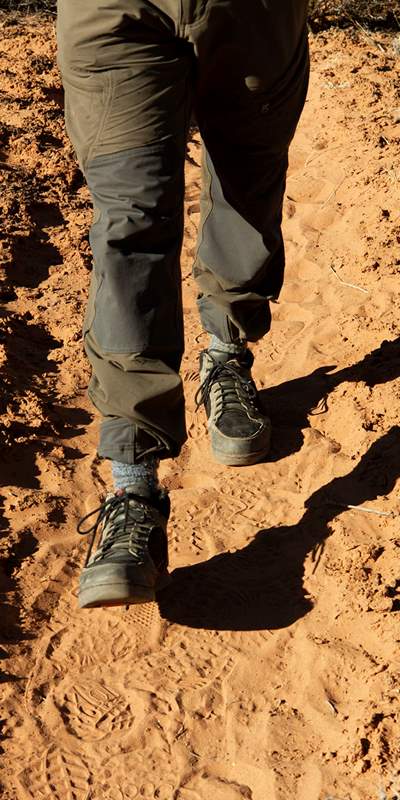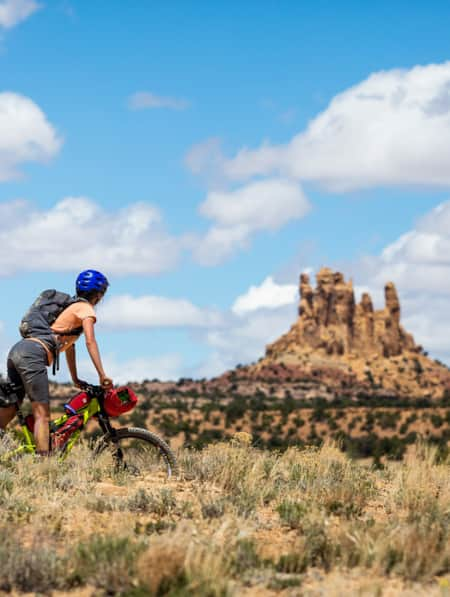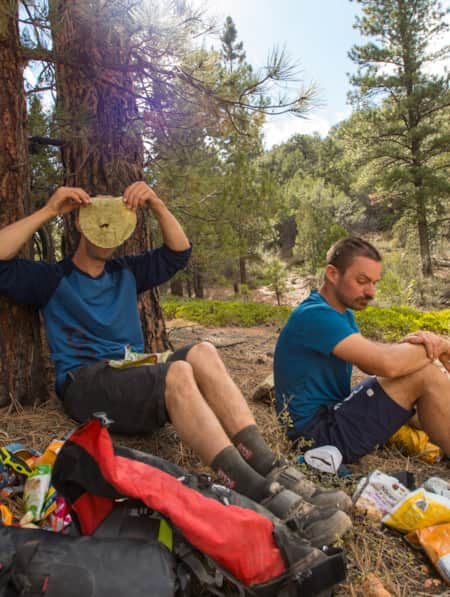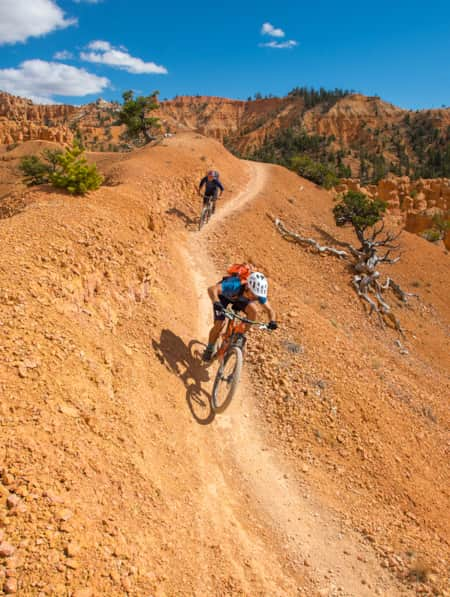Top 5 Rules of the Ride: How to Mountain Bike Responsibly on Utah Trails


On a busy trail, who must yield to whom? Horses (or wildlife, generally) have top priority, followed by hikers and, then, mountain bikers.
Photo: Ryan Salm
1. Yield to Wildlife and Hikers
First, on a busy trail, who must yield to whom? Horses (or wildlife, generally) have top priority, followed by hikers and, then, mountain bikers. Riders of any age on any type of trail (whether it’s singletrack, gravel road or slickrock) must yield to wildlife and hikers. In most cases, that means pulling off to the side and allowing them to pass. Often, hikers will gratuitously and encouragingly wave you by. If so, act like a local by thanking them and letting them know how many others are behind you in your group so they can stay alert. You can holler something like: “Three more!”
2. Respect the Flora and Fauna
This should be obvious, but don’t feed, harass or otherwise interfere with wildlife for their safety — and yours. If you encounter a moose or any other animal on the trail, do not attempt to yell at it, reason with it or chase it away. Mountain bikers don’t speak moose and could be misinterpreted by the beasts. This is especially dangerous during the spring-early summer calving season! If you spot a moose or its young near a trail, move past them if possible. Don’t stop to take a selfie unless you want to include your X-ray pics, as well.
If animals are sunning themselves in the middle of the trail, then stop and retreat. Yes, in the case of moose, bear and mountain goat, you might have to go back 100 yards, take a water break or leisurely lunch and wait for it to move on, or if it doesn’t, then search your trail map for a different way back to your car or hotel. Under no circumstances should you try to “shoo” wild and enormous animals! It’s not uncommon for a mamma moose to charge mountain bikers and hikers who get too close to her young.
Similarly, don’t bust the crust — stay on the trail. From alpine wildflowers to the desert cryptobiotic soils, Utah wildlife starts at the trail's edge. (Read: "Soil Sleuth: Protecting Utah's Living Landscapes")
"Don’t bust the crust — stay on the trail. From alpine wildflowers to the desert cryptobiotic soils, Utah wildlife starts at the trail's edge."

3. Practice Patience When Passing
While the former rules sound almost as exciting as the ride itself, the following two rules cover the most common, the most contentious and possibly the least understood scenarios experienced by mountain bikers visiting Utah.
If a mountain biker wants to pass a slower rider on a singletrack trail, then the passing biker should wait for the other to find a spot to pull the bike off the trail safely before going by. The most courteous way to do this is for the passing biker to ring her bell or simply ask if she can pass. Then, please, be patient. A safe place to stop is an entirely subjective choice for the rider stopping, especially a slower one. If both bikers are climbing, they should be prepared to wait until both get to the top so neither rider loses momentum.
4. Give Uphill Riders the Right-of-Way
If two bikers are riding toward each other, don’t play chicken! The rider traveling uphill has the right-of-way because it is tough to start pedaling uphill from a dead stop. The mountain biker going downhill shouldn’t continue bombing down the run but, instead, pull aside, allowing the uphill rider to pass.

Your mountain bike backpack should always include tools and supplies to repair a bike on the road.

Be patient when passing — always wait for the biker ahead to find a spot to pull safely off the trail before going by.
5. Be Prepared on the Trail
In addition to your camera, every mountain biker should carry some supplies. Don’t rely on your cell phone to call for assistance — coverage is spotty on the undulating mountain trails near Park City and Salt Lake City and even worse in more remote areas around Moab or St. George. Foremost, every mountain biker should carry an adequate amount of water for a high-intensity ride in one of the country’s most arid states. No matter what happens to you or your bike, dying of thirst will likely happen first. So a good rule of thumb is: Whatever amount you drink at home, carry twice as much on your ride.
Similarly, bring snacks even for a short ride. Mountain biking requires a lot of energy and you don’t want to “bonk” (when a biker suffers instant fatigue like a car using its last drop of gas) halfway up the climb. The other thing in your mountain bike backpack should be tools and supplies to repair a bike and, preferably, a friend who can actually use them. It doesn’t take a rocket scientist to fix a flat tire, but you might want to watch a few YouTube videos or chat up the folks at the bike shop to make sure you could MacGyver your way back to camp if necessary. If all else fails, it’s perfectly acceptable to hail a rider to ask for assistance or to walk your lame steed back to the trailhead.
"Don’t rely on your cell phone to call for assistance — coverage is spotty on the undulating mountain trails."
Bonus Tip: Know When To Ride a Trail
If your shoes or tires leave a print on a muddy, wet or damp trail, then don’t ride it. The tracks will leave ruts that “catch” the next riders’ tires and destroy all the volunteer hours used to maintain the trail. Even locals will colorfully call you out for this breach of trail etiquette. Thankfully, because of Utah’s extremely dry climate, trails typically dry out quickly. See more tips for how to recreate responsibly.
Mountain biking is one of Utah’s most popular activities enjoyed by riders of all ages and skill levels on trails shared with other adventurers and animals. Be able to fly down that flow trail by, first, understanding and respecting the rules of the ride.












